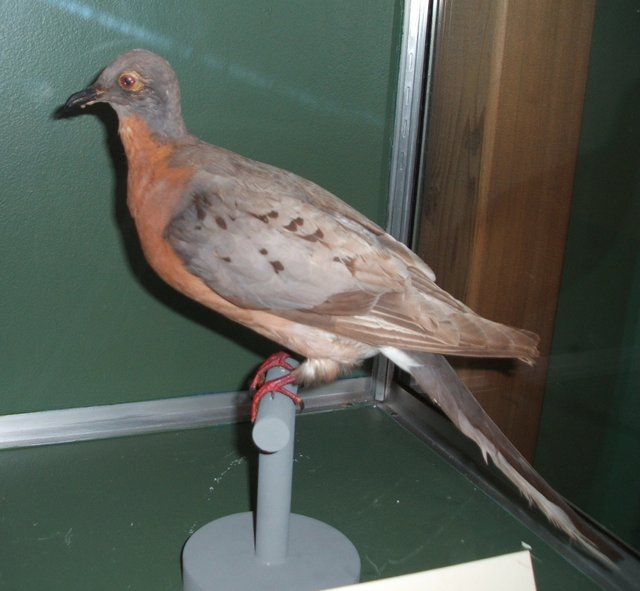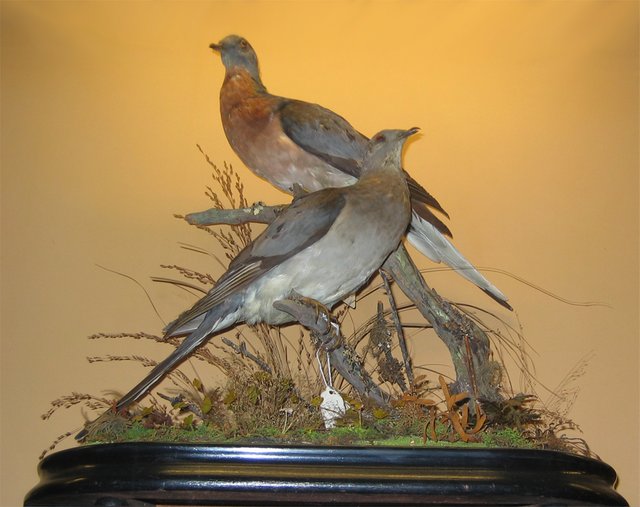How the Passenger Pigeon was hunted to extinction
In the last 200 years, humans have hunted a great number of animal species to extinction, and today I want to share the story of how we as a human race managed to decimate the entire population of Passenger Pigeons (Ectopistes migratorius). This pigeon used to be very common all over North America, with an estimated population at 3 – 5 billion pigeons when there was good conditions for them.
The Passenger Pigeon was used as a food source for Native American long before the arrival of the European colonization, but never really had any population related problems before America became populated by European people in the 19th century.
The Native American tribes preferred to hunt the juveniles, and in some communities it was even considered a crime to disturb or hunt the adult pigeons. This was a far better conservation strategy than the European people applied when they colonized America, and the hunting from the Native American tribes did not really affect the population very much.

A stuffed Passenger Pigeon at the Boston Museum of Science. Image by C. Horwitz, posted under the GNU Free Documentation License.
Why was the Passenger Pigeon so heavily hunted?
At first glace one would not expect the pigeon to be hunted. It is a very fast bird that can fly up to 100km/h, and it migrated over vast distances. However, the reason it got so heavily hit by hunters was because it lived in really large flocks with multiple thousand birds!
The were extremely easy to kill, and most people did not consider killing the Passenger Pigeons to even be hunting. Amateur hunters could bring down 5-6 pigeons with a single shotgun blast, so this became a very easy source of food in the settler areas. Professional trappers could kill thousands of bird in a single day, and large firms hired organized hunters to provide pigeons as food that could be sold in stores.
The easy hunting made the pigeons into a very cheap source of food, and it was commonly sold in villages and cities. A lot of people also kept trapped birds in cages to use as a food source in the winter when crops were less available. This cheap source of food was really needed in a lot of settlements, and was able to provide people with food in areas that would otherwise be harsh.
Due to the abundant nature of the pigeon, they were also popular for hunting events where people could compete to kill the most birds. According to an article, in some contests you would have to kill 30,000 pigeons in order to claim a prize! This is a pretty good example on the extreme scale people killed these birds in.
People started to locate where the pigeon had their breeding ground, and killing all the breeding animals at the location was an effective way to stop the population from being able to recover from the extreme hunting. In these locations, 50,000+ birds could be killed each day during the breeding season, and very few birds were able to successfully reproduce and give birth to new pigeons.

A stuffed pair of the Passenger Pigeons. The male is the one with the brown neck (in the back). Image by Wikimedia user Dante Alighieri, posted under the GNU Free Documentation License.
Why did no one try to stop the extreme hunting?
Due to the fact that there was originally billion of the pigeons, no one really seemed to notice that the population declined. People kept hunting them, and there would always be many more birds left. This went on from about 1800 to 1870, so it provided a big stream of food for lots of years before the population decrease became noticeable between 1870 and 1890.
We also have to remember that information was less available at the time, and most people did not even have a concept of species becoming extinct. Some people tried to advocate against the continued hunting, and was kind of working, and in 1897 Michigan passed a bill to have a 10-year break from hunting them, in order to get the population to rise again. Pennsylvania also tried this bill, but later disregarded it. However, at this point in time it was already way to late, and the population was so small that it was doomed to extinction. The poor farmers in the area also relied on pigeon meat to use as food, and would continue hunting them even when it was not permitted.
From the middle of the 1890s the pigeon became increasingly rare, and had at this point probably stopped breeding in the wild. From this point onwards, only small flocks of the pigeon was observed, and these were usually hunted for some easy food when they were found.

A captive Passenger Pigeon in 1898. Image by J. G. Hubbard, posted under the Public Domain tag, originally published in 1913.
Thanks for reading
I wrote this post because I think the Passenger Pigeon is a good example on how humans have hunted species to extinction. The pigeon is only one of many species, but the sheer amount of the pigeons that were killed is almost absurd, so I think it is a good thing to know about. No matter how abundant an animal species can be, humans will find a way to eliminate it if they are determined.
Anyway, thank you for reading this depressing post. I think I will try to post about a successful conservation story within the next day to show that there is hope for the endangered animals, and not just sad stories like this one.
If you enjoy posts about animals, biology or nature, make sure to follow me for more!
Sources
I pretty much only used the Wikipedia article on the Passenger Pigeon for this post. It is very lengthy, and has a lot of good information about the pigeon, and cites many good, historical sources.
Here is another good argument for why cloning is a good thing.
Cloning is a great idea, but I think we also need to work a bit on our fundamental relationship with the other life forms, minerals and fellow humans. For example: Man clones pigeons from old DNA. Pigeons crap all over everything. Man eradicates pigeons again along with wolves, coyotes, beers, cloned sabre tooth tigers, etc.
Things are changing though, so hopefully we can restore some balance and improve conservation.
Pigeons are crapping all over everything now. What harm would one more species do? No big loss for "beers" :-D
I guess I've got beers on the brain. Oh well, it's Friday, lol. :D
In all seriousness. We have wiped out thousands of species of animals and justify it but quoting Darwin in "survival of the fittest". Darwin was referring to the natural order of things. Man's interference is not the natural order of things.
Good point! Actually there are many examples of cooperation in nature as well. Some herd animals work together and take votes to figure out where the herd will roam. The natural order of things is difficult to see sometimes - our success depends heavily on our ability to communicate and cooperate together. I believe a greater shift towards cooperation and away from the scarcity driven mentality of "survival of the fittest" will help end the sixth mass extinction of life on this planet that we are currently experiencing.
Amen!
I don't think it would be possible with this species, at least not with our current technology. The DNA in the stuffed animals are probably degraded, and unusable for cloning purposes.
The reason as to why some scientists are trying to clone mammoths and animals from the ice age is because they have been frozen, so their DNA degrades a lot slower. I sadly don't think anyone have any frozen Passenger Pigeons laying in their freezer (and the DNA would probably have been degraded even if stored properly, which is also the reason why they have so much trouble with cloning mammoths).
DNA takes thousands of years to erode. That's why mammoths are so hard. They died off that long ago. Feathers should still have sufficient DNA . That's why cloning dodos is on the discussion table.
Yea, seems you are right. I was just checking it out, and it seems like both the feathers and the bones from the Passenger Pigeon have enough DNA to sequence and possibly clone it.
That was a sad reading. People can be stupid. Brings back to mind the old children's story about the goose that lay golden eggs.
Yeah, it is pretty sad. However, the people that hunted them probably had no idea that they would be able to go extinct. There were billions of birds, so I guess they were under the impression that they were infinite. They were probably just getting some easy food for their family. But yea, it is pretty sad now that we know how the story ends :(
You should read the Audubon Society's page on the demise of the passenger pigeon. It went beyond hunting. They used poison, fire, whatever they could use to eradicate the bird. When I started asking some old guys born in the 1930s and 1940s who knew even older farmers who were around when the pigeon was around why this had happened he said the birds were known to drop into a farmer's field and eat everything overnight, bankrupting farmers. The passenger pigeons were locusts to them. They had every intent of eradicating them. It wasn't a mistake.